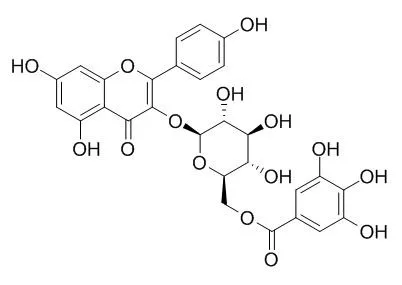| In vitro: |
| Journal of Functional Foods, 2018, 45:444-451. | | Brazilian insulin plant as a bifunctional food: Dual high-resolution PTP1B and α-glucosidase inhibition profiling combined with HPLC-HRMS-SPE-NMR for identification of antidiabetic compounds in Myrcia rubella Cambess.[Reference: WebLink] | Six species of Myrcia , commonly known as 'insulin plants' in Brazil, were assessed for their potential as functional foods.
METHODS AND RESULTS:
Thus, dual high-resolution α-glucosidase/PTP1B inhibition profiling and HPLC-HRMS-SPE-NMR analysis were used to identify the antidiabetic constituents of the crude ethyl acetate extract of M. rubella Cambess. A total of 31 compounds were identified, including seven α-glucosidase inhibitors with IC 50 values between 0.6 and 22.4 μM: 4,5-dicaffeoylquinic acid, isoquercitrin, quercetin-3- O -β- d -glucuronide,
Kaempferol 3-O-(6''-galloyl)-beta-D-glucopyranoside, quercetin-3- O -(6″-malonyl)-glucopyranoside, quercetin-3- O -(6″-( E )-feruloyl)-β- d -glucopyranoside, and quercetin-3- O -(2″-( E )-sinapoyl)-glucopyranoside as well as three strong PTP1B inhibitors with IC 50 values between 0.4 and 3.1 μM: kaempferol-3- O -α- l -rhamnoside, astragalin, and arjunolic acid.
CONCLUSIONS:
These results show that M. rubella is a potential bifunctional food for management of type 2 diabetes. |
|






 Cell. 2018 Jan 11;172(1-2):249-261.e12. doi: 10.1016/j.cell.2017.12.019.IF=36.216(2019)
Cell. 2018 Jan 11;172(1-2):249-261.e12. doi: 10.1016/j.cell.2017.12.019.IF=36.216(2019) Cell Metab. 2020 Mar 3;31(3):534-548.e5. doi: 10.1016/j.cmet.2020.01.002.IF=22.415(2019)
Cell Metab. 2020 Mar 3;31(3):534-548.e5. doi: 10.1016/j.cmet.2020.01.002.IF=22.415(2019) Mol Cell. 2017 Nov 16;68(4):673-685.e6. doi: 10.1016/j.molcel.2017.10.022.IF=14.548(2019)
Mol Cell. 2017 Nov 16;68(4):673-685.e6. doi: 10.1016/j.molcel.2017.10.022.IF=14.548(2019)